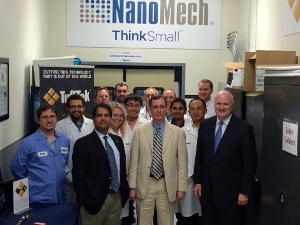Aug 4 2014
Today, the Chief Scientist for the U.S. Government Accountability Office (GAO) Dr. Timothy Persons visited Northwest Arkansas to meet with NanoMech and tour their facilities in Springdale and Fayetteville.
 Dr. Timothy Persons tours NanoMech's factory and labs accompanied by some of the company's scientists and executives. (Photo: Business Wire)
Dr. Timothy Persons tours NanoMech's factory and labs accompanied by some of the company's scientists and executives. (Photo: Business Wire)
At the request of the U.S. House of Representatives Committee on Science, Space, and Technology, Dr. Persons led a strategic forum on nanomanufacturing to explore participants’ views concerning: 1) the anticipated scope of future nanomanufacturing developments and related effects; 2) U.S. investments and competitiveness in nanotechnology R&D 3) options for enhancing U.S. nanomanufacturing competitiveness; and 4) issues in addressing the environmental, health, and safety implications of nanomanufacturing. As a result of key input from expert forum participants, which included NanoMech Chairman & CEO Jim Phillips, the GAO published a 2014 report titled Nanomanufacturing: Emergence and Implications for U.S. Competitiveness, the Environment, and Human Health (GAO-14-181SP). Dr. Persons also wrote an Op-Ed for Scientific American titled Does the American Innovation System Need a Reboot?
Dr. Persons visited NanoMech’s advanced nanomanufacturing plant and laboratories, including a tour of the 25,000 sq. ft. expansion that is underway and due for completion in September.
“The important innovation NanoMech is accomplishing in nano-engineered and manufactured coatings and lubricants is truly breakthrough and exemplifies American values for pushing technology progress for the benefit of mankind,” said Dr. Persons. “NanoMech is a shining example of the U.S. ecosystem fostering public-private partnerships, University tech transfer and commercialization, and the determination to succeed on an increasingly competitive global stage.”
“NanoMech is proud to host Dr. Persons, given his tremendous reputation in the field of science, and his dedication to increasing American competitiveness through finely tuned public-private partnerships that encompass updated 21st-century global strategy and tactics,” Phillips said. “U.S. based, leading edge technology manufacturers are intensely driven to succeed based on wit, grit and time sensitive achievement, but we have to increasingly compete against those that are State-run, who bring unlimited capital, and scale into the competitive production arena in pursuit of product advancements and bolstering knowledge based jobs.”
Deborah Wince-Smith, CEO of the Council on Competitiveness and also a member of NanoMech’s Board of Directors, praises NanoMech for their innovative work. “In a world of turbulence, transition and transformation, nothing matters more to the competitiveness of companies and countries than innovation and manufacturing prowess.
“The ability to develop and deploy the most cutting-edge tools and products to bolster U.S. advanced manufacturing will deliver outsized benefits to the U.S. industrial base. NanoMech and TuffTek®are at the leading edge of a resurgent U.S. manufacturing capability - one that is not dumb, dirty, dangerous and disappearing; but is smart, safe, sustainable and surging.”
Hosted by Dr. Ajay P. Malshe, Founder and CTO of NanoMech and Distinguished Professor of Mechanical Engineering, and Dr. Greg Salamo, Distinguished Professor of Physics and Executive Director of the Nano Materials Science and Engineering Institute at the University of Arkansas, Dr. Persons toured the Institute including the ultra-high resolution materials analytical facility. “The Nano Materials Science and Engineering Institute is a major asset to the region as leading nano engineering companies, like NanoMech can utilize the vast array of scientific apparatuses including world-class electron microscopes to help advance their technology and industry breakthrough products that increase Arkansas’, and at large, America’s global manufacturing competitiveness,” Malshe said. NanoMech is the largest industrial user and rents the Institute’s materials analytical facility including electron microscopes for ultra-high resolution cross-sectional nanostructural and elemental analysis, X-ray diffraction for crystallographic analysis, etc.